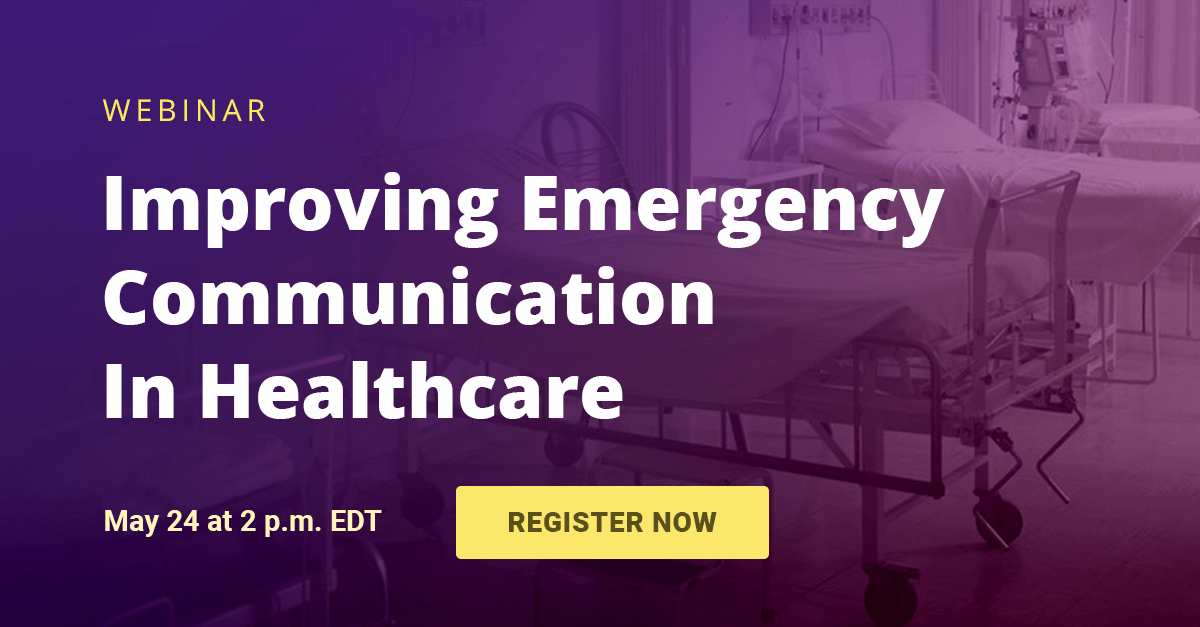Is Your Healthcare Organization’s Emergency Communication Compliant With The CMS Rule?
Meg Nash, MPH, emergency preparedness expert and FEMA trainer, joins Danielle Ricci, Sr. Director of Marketing for AlertFind, to discuss what healthcare organizations need to know about the CMS Emergency Preparedness Rule and how they can get the most from their emergency communications planning.
In our upcoming webinar,she’ll discuss how hospitals and other healthcare organizations can work together to create emergency preparedness plans to share resources and provide continuity of care for patients during an emergency.
Here are some highlights from their conversation:
Danielle Ricci: Tell us about the CMS Emergency Preparedness Rule and what role communications plays in it.
Meg Nash: The CMS Emergency Preparedness Rule went into effect Nov. 16, 2017, and applies to all healthcare organizations that receive Medicaid and Medicare funding. This includes, but is not limited to:
- Hospitals
- Critical access hospitals
- Skilled nursing facilities
- Nursing homes
- Ambulatory surgical centers
- Community mental health centers
- Inpatient psychiatric services
- Home health agencies
The purpose of the rule is to establish national emergency preparedness requirements to ensure adequate planning for both natural and man-made disasters, and coordination with federal, state, tribal, regional and local emergency preparedness systems, according to the CMS.
Establishing a communications plan is one of the four main pillars of the emergency preparedness requirements.
Danielle Ricci: I want to set the stage about the importance of communications with this fact: Communication is cited as the biggest failure in 80% of all training after-action reports. Why do you think that is?
Meg Nash: When I do training sessions, I talk about how we speak to everybody every day, and we think we're communicating. We send emails, and we have phone calls and texts, and we use structured systems, and we communicate on a regular basis. Things go okay, so we think that there's no concerns, but when we go into a crisis communication situation, it becomes increasingly complex.
When we exercise our emergency preparedness plans, we need to look at our communications plan. You have to practice using your emergency notification system and notifying different groups. You have to be sure that everyone is receiving your messages. And you need to see how effective these communications are. You may think you’re sending out clear direction, but if people don’t understand what they need to do, then those messages are failing.
Here are the guidelines you need to follow for your alerts: it’s got to be short, it's got to be direct, it's got to be reinforced and it has to be on multiple channels. Your alerts need to be actionable. Any miscommunication you have during an event can have huge, negative effects.
Communications have to be front and center for anything you're doing in any exercise and they have to be evaluated for their effectiveness. You have to ask if the communication was clear and effective? If not, you need to take action to fix it and add those revised communications back into your plan.
Danielle Ricci: How can healthcare organizations better communicate with all employees when an emergency such as an active shooter or workplace violence forces them to close down one section but other departments must continue to function?
Meg Nash: For hospitals, it’s really important to know the precise location of your staff members. You need to be able to communicate with people in specific locations to give and receive information. For example, you need to be able to lockdown the Emergency Department but let the scrub nurse in one of the operating rooms know that they’ve been cleared to continue with their procedure. Or you need to be able to tell them that an armed security guard has been posted outside the operating room and they can speak with him to get more information.
Your communication plan can indicate that you will contact all the scrub nurses in an event like this to give them the information about the incident and what they need to do. As part of your training they know they’re in the role that will receive the communication and will be responsible for passing on information to the appropriate people. This mitigates the risk of someone interrupting the procedure and also lets them know what the next steps are.
As part of your planning, you can create sub-groups by roles or communication needs. That way you can send out segmented alerts with detailed actions they need to take. This also allows the incident commander to ask detailed questions such as “Are you in an active surgical procedure? Which suite are you in? Have you opened the patient?”
Each healthcare organization needs to decide what level of communication and type of message they want to send. For complex organizations, they may need to define the message differently based on where people are. For simple organizations, they may just need to send out a message that is actionable and lets everyone know what they need to do.
Danielle Ricci: Why is two-way communication so important?
Meg Nash: Two-way communications are essential in rapidly-evolving situations or where there’s poor situational awareness creating a high degree of risk to patients, staff or facility. Incident commands, coordination with public health, emergency management, and law enforcement rely on current information about a threat.
We also know that it’s going to have holes. So two-way communications allow for near real-time relays of information from on-scene incident command about sheltering, revised evacuation or emergency procedures to be taken.
The two-way part really comes into play when we get information back from our stakeholders and are able to get more information about an evolving situation, possible injuries, immediate resources, damaged infrastructure, or ongoing threats to patients or staff.
Two-way communication definitely allows for more on-the-spot decision making so that when we're making our plans we don't necessarily need to envision every eventuality and every possible modification to it. We can make the best decisions at the best time to push the best information out based on the situation. In today's world, some situations benefit from the ability to make a decision in that moment and get that information out immediately.
Danielle Ricci: Why is it so important that you remain flexible during a disaster? How does your communications strategy play into that?
Meg Nash: In situations like active shooter or an anthrax infection, we are expecting that those situations may not go as we practiced. So we don’t want to worry so much about why this disruption is happening. Instead you want to think about how are you going to communicate to people to avoid that danger. So if it's the WiFi is down and now the bring your own device network is no longer available, then what do you do?
So it's not so much the threat, it's more the effect of that threat.
So if people look at it from that perspective of "If I can't communicate with people," and stop thinking about, "I can't communicate with people because," they tend to get more flexible and more creative.
So if they can’t send out a mass alert, then they know they go to this person on the third floor and ask them. And that person, like a physical phone tree, then distributes this information.
It doesn't really matter what caused the emergency, it’s more important to focus on the effect of it. I think we've gotten so focused on what caused it that people get kind of bogged down. They're like, "Oh, my God. How many things do you want me to think about?" And it makes it much more structured to say, "I'm not really so concerned that it's a tornado. I'm just concerned that the tornado is going to take out the power." Then you focus on what they need to do next.
Danielle Ricci: How do you identify the key stakeholders you need to include in you planning?
Meg Nash: The first and most important step is to decide who needs to know. And by that, I suggest you look at how are you framing a message. “Who does it provide value to? Who will change their actions based on your information? Whose personal safety will be better protected? Am I protecting my business? Am I protecting the critical functions that I provide for my clients, patients and other stakeholders?”
You have to be able to evaluate what provides value now rather than just something that's information for information’s sake. You really want to limit it to actionable information. If you push too much information, ask too many inconsequential detail questions, the data may be interesting, but your message will be diluted.
Danielle Ricci: One of the CMS requirements is that healthcare organizations include other community healthcare providers in their planning and training. How should organizations approach this?
Meg Nash: As part of the CMS Emergency Preparedness Rule, healthcare organizations need to work with other organizations in their community to plan for emergencies. To decide who these stakeholders are, organizations need to ask themselves who they would plan with and share resources with in the event of a disaster?
You may work with an ambulatory surgery center because you’ll need to transfer patients there. Or you may use some of their nurses to staff extra shifts. As part of your planning, you need to think about what will be needed if you transfer patients there. How will you track them to ensure continuity of care? How will I let them know what to expect? How will I know when to transfer them back to our facility? These are just a few questions to start asking.
By looking at this network of additional resources, you can better ensure you have the facilities, staff and support services you’d need to take care of patients in the event of an emergency.
Join Meg and Danielle as they help healthcare organizations understand the new communications requirements and get the guidance they need to implement them in our next webinar, “Improving Emergency Communications Under The Emergency Preparedness Rule: Are You Ready?,” at 2 p.m. EDT on Thursday, May 24.
Register Now!

You are well on your way toward protecting your staff and organization.
Take the next step toward protecting your organization by learning more about emergency notification systems and the vital role they play in your emergency preparedness plan.
